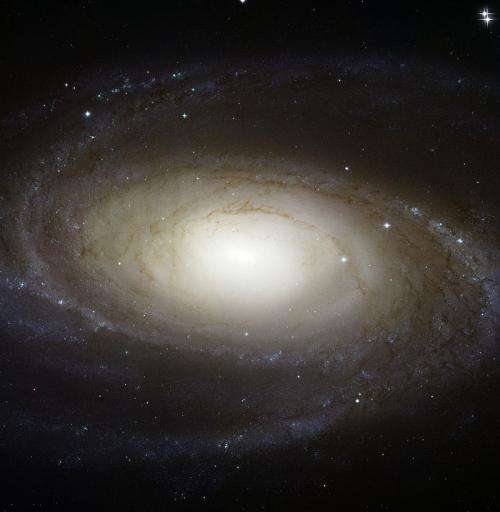Fat or flat: Getting galaxies into shape

Australian astronomers have discovered what makes some spiral galaxies fat and bulging while others are flat discs—and it's all about how fast they spin.
The research, led by the International Centre for Radio Astronomy Research (ICRAR) in Perth, found that fast-rotating spiral galaxies are flat and thin while equally sized galaxies that rotate slowly are fatter.
The study was published today in the prestigious Astrophysical Journal and was part of "The Evolving Universe" research theme of the ARC Centre of Excellence for All-sky Astrophysics (CAASTRO).
ICRAR Research Associate Professor Danail Obreschkow, from The University of Western Australia, said it is a much-debated mystery why galaxies look so different to each other.
"Some galaxies are very flat discs of stars and others are more bulging or even spherical," he said.
"Much of the last century of research has been dedicated to understanding this diversity of galaxies in the Universe and with this paper we've made a step towards understanding how this came about by showing that the rotation of spiral galaxies is a key driver for their shape."
The study looked at 16 galaxies—all between 10 million and 50 million light years from Earth—using data from a survey called THINGS.

"The THINGS survey shows you the cold gas in the galaxies, not only where it is but how it moves," Dr Obreschkow said.
"That's a crucial point if you want to measure the spin, you can't just take a photograph, you have to take a special picture that shows you the motion."
Dr Obreschkow said the shape of a spiral galaxy is determined by both its spin and its mass and if you leave a galaxy on its own for billions of years both quantities will stay the same.
He said the way galaxies are formed looks a bit similar to a carousel made of an elastic disc.
"If the carousel is at rest, the elastic disc is quite small," Dr Obreschkow said.
"But when the whole thing is spinning the elastic disc becomes larger because it's feeling the effects of centrifugal force."
Our own Milky Way is a relatively flat disc with only a small bulge, the shape of which can be seen in the night sky.
"The white band of the Milky Way across the sky is a relatively thin band of constant thickness. However when you look right at the centre near the Sagittarius constellation you can actually see a thickening of the Milky Way, which is the bulge," Dr Obreschkow said.
He and co-author, Swinburne University Professor Karl Glazebrook, were able to measure the effect of spin on galaxies more than ten times better than anyone previously.
The study used data collected at the Karl G. Jansky Very Large Array in the United States, one of the most famous radio telescopes in the world and a significant pathfinder for the Square Kilometre Array.
Journal information: Astrophysical Journal
Provided by International Centre for Radio Astronomy Research




















